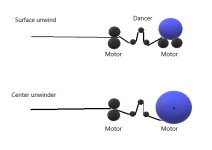Hey,
I'm having trouble thinking about this one...
If I have a roll (20lbs), sitting on a roller with bearings and it takes very little to cause it to roll (like a wheel or something). How would I go about calculating the force required to unroll it?
There will be two pinch rollers pulling the material, so I wasn't sure about the physics behind it since while being pulled, it is on bearings and rolling freely.
Do I need just enough force to move the pinch rollers?
or
Do I need to look at the mass of the product rolling as if it were moving the entire thing?
Thanks!
I'm having trouble thinking about this one...
If I have a roll (20lbs), sitting on a roller with bearings and it takes very little to cause it to roll (like a wheel or something). How would I go about calculating the force required to unroll it?
There will be two pinch rollers pulling the material, so I wasn't sure about the physics behind it since while being pulled, it is on bearings and rolling freely.
Do I need just enough force to move the pinch rollers?
or
Do I need to look at the mass of the product rolling as if it were moving the entire thing?
Thanks!



